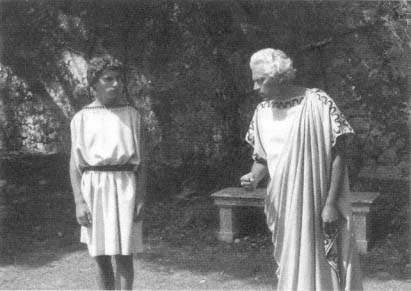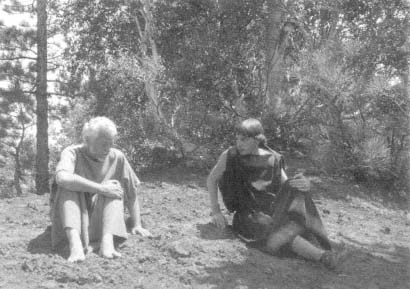An Alternative Cultural Identity
In his institutional study of the project that unites the disparate artists of the New German Cinema, Elsaesser writes of their search for Germany and a German audience. In a period when German unification raises yet again the question of German national and cultural identity, the contradiction between economic and military power and cultural feelings of inferiority, racial versus civil definitions of identity and otherness—all this makes the project of Straub/Huillet, from the very beginning of Machorka-Muff , as relevant today as it ever was. This, more than the incidental "theoretical" interest of their work and even more than its place in a hypothetical "film history," is the place they
would claim for their films—a contribution to the cultural shaping of a new, non-nationalistic and nonmilitarist Europe. As they wrote in the introduction to Antigone ,
So, one year before the Year of Europe, 1992, we want to attempt the most European of all films: a great Greek dramatist, two German poets, German actors from West and East Berlin (Schaubühne , Gorki Theater), French technicians (Camera: William Lubtchansky, with whom we shot the Kafka film in Hamburg in 1983), the Sicilian landscape and a director with three fatherlands: Germany, Italy, France. Is there a better celebration of the true Europe?[67]
The post-1968 leftist identity, the problematic identity of New German Cinema, and the German identity in general are all typified by melancholy; the films of Straub/Huillet are not. Instead they are touchingly positive about Germany as perhaps only foreigners who know its dangers but also its beauties can be. But their "love of Germany" manifests itself not by representing the country but only the displacements of its language and cultural artifacts.
The difference between the allusions to Hollywood cinema in Wenders and Fassbinder, on the one hand, and in Straub/Huillet, on the other, also relates to the context of a German subjectivity or national identity. For the New German Cinema, as Elsaesser and Timothy Corrigan have written, dependence on Hollywood was both a problem and a source of identification.[68] Thus it became a project of the New German Cinema to reproduce aspects of Hollywood in their films and even in the personae of the directors. Wenders and Fassbinder rework genres from Hollywood and include characters who mimic characters from Hollywood movies, and both these tactics refer to the situation of the West German cinema and to their own situation as derivative. Clearly Fassbinder and Wenders have been able to do "original" work with this derivative material as an aspect of its composition, often taking the physical form of excerpts from films or songs and the presence of the film apparatus itself within the narrative framework of the film. Examples would be Kings of the Road, In a Year of 13 Moons , and The State of Things . The world of the cinema becomes part of the texture of the psychological world in which their films operate. As Wenders's character in Kings of the Road puts it, "The Yanks have colonized our subconscious."
While these allusions to Hollywood are thus opaque and identifiable as such, allusions to Hollywood and early cinema in Straub/Huillet films are transparent. Indeed, in most cases they claim they are subconscious and only become visible—even to the filmmakers—after the film is finished. The nature of this connection to past cinema is thus technical and formal and not thematic or narrative. The shooting or projection of a film is never present in a Straub/Huillet film. The utopian Germany they evoke through the cinema is a Germany without the cinema.
But the evocations of American cinema in Fassbinder and Wenders also block the way for Straub/Huillet films, they assert, since these products function as a substitute for a confrontation with the real thing. The complacency that results—they term it ignorance and arrogance—allows people to consume a "nostalgia for the American cinema, when the audience has seen nothing of Chaplin, Griffith, or John Ford." By projecting their dreams of the cinema into their films, Wenders and Fassbinder collaborate in the narrowing of audience demand and distribution that has gradually excluded even Godard from general distribution. There is no resistance or solidarity to be found on the basis of such films that accept the terms of Hollywood marketing. For, as Huillet has put it, "Cinephilia is also a lack of ambition."[69]
Another method of re-creating a film culture that Elsaesser observes in the New German Cinema is the "author as intertext," the interconnection between films due to the recognizability of their actors. Elsaesser gives as examples Fassbinder's ensemble, Rüdiger Vogler in Wenders's films (and Von Trotta's Marianne and Juliane ), and numerous others.[70] Like the choice of interconnected film titles, this is in part a marketing device that also adds to the reality effect of the "film world" as a counterpart to the real world and German society.
Where Straub/Huillet's work enters this intertextuality, however, it applies it self-consciously as part of a spectrum of acting styles that spill out of the cinema fiction into documentary and lived experience. The past roles and skills of the professional actors they use thus join a collage of messages that includes other manifestations of language, literature, and the biographies of individuals. For example, the theatrical fulminations of Mario Adorf, Alfred Edel, and Werner Rehm reveal aspects of their own professional lives, the role they are playing, and the construction of cinema simultaneously. The choice of the equally professional Libgart Schwarz for the most extreme expression of suffering and pathos subtly distances the audience from those emotions as well. The casting of the controversial journalist and author Erich Kuby as General Machorka-Muff, or Howard Vernon as Hermocrates/Manes in the Empedocles films doubly alludes to each man's other roles and their political context.[71] Protagonists in Straub/Huillet films, however, are almost always played by (usually young) lay actors who bring experiences to their performance of the texts that come from outside the cinema or theater. Gustav Leonhardt as Bach or the gentle and earnest German teacher and amateur violinist Andreas von Rauch as the hero Empedocles are examples. Perhaps the most powerful acting of all is delivered by Gottfried Bold as the banker in History Lessons . Bold was editor of a trade union newspaper in Cologne, who had been fired from an earlier job for refusing to write GDR (the official name of East Germany) in quotation marks as the right-wing press always did. The experience of acting in a Straub/Huillet film is also historicized by the fact that Vladimir Baratta, Howard Vernon, and Andreas von Rauch repeated their roles from Empedocles

Vladimir Baratta as Pausanias and Andreas von Rauch as Empedocles in The
Death of Empedocles (1986). Courtesy Edition Manfred Salzgeber, Berlin.

Andreas von Rauch as Empedocles and Vladimir Baratta as Pausanias in
Black Sin (1988). Courtesy Edition Manfred Salzgeber, Berlin.
in the later version, Black Sin . The second film thus documents their physical aging in a temporal world separate from the texts.
Finally, we will look briefly at the evocation of German history and the German landscape as an aspect of mourning work or the search for Heimat. Elsaesser stresses that the search for Heimat after Germany's shame and fragmentation stands behind much of New German Cinema production. Even the exotic faraway lands sought out by Herzog, he asserts, are expressions of this German longing. The confrontation with the Other, either in Herzog's romantic exoticism or in Ulrike Ottinger's more ethnographic variety, finds its counterpart in the mournfully nostalgic investigation of German lands in Reitz and Wenders. These images of Germany and the world evoke a sense of distance and loss as the basis of the damaged German identity of which so much has been written. The impossibility of living in these spaces, their unreachable artificiality, is underscored by Wenders's juxtaposition of German landscapes with the imaginary American Southwest. These are not images of the world but of the postwar West German mental landscape.[72]
As they do not attempt to represent the German public, Straub/Huillet also do not parallel this attempt to represent the world as a counterpart to a German identity. The landscapes they photograph, which Elsaesser links to Herzog's exotic locations as signs of abstract "otherness," are instead sites bearing visible signs of human history. Although Straub/Huillet do not show contemporary Germany, they attempt to make of the German language itself a home. As Straub has put it, "Language is the house one is born in or works in or suffers in or enjoys in. And if one has no connection to language, no relationship with language, then there are no structures anymore; there's nothing there anymore."[73] As later chapters will investigate, Straub/Huillet's presentation of nature and language, in contrast to or in harmony with a narrative/narration, traces "the history of barbarism" that Benjamin spoke of and records the signs of resistance. Straub used a more graphic metaphor in describing the price paid for progress that is behind the appearance of the world: "Every step one takes is, without knowing it, into a puddle of blood."[74] Rather than a melancholy fixation on Germany and its guilt, however, Straub/Huillet seek the seeds of resistance in the exile of language. This displacement, Europeanization, and humanization of German culture can only be welcomed given the legacy of this century.